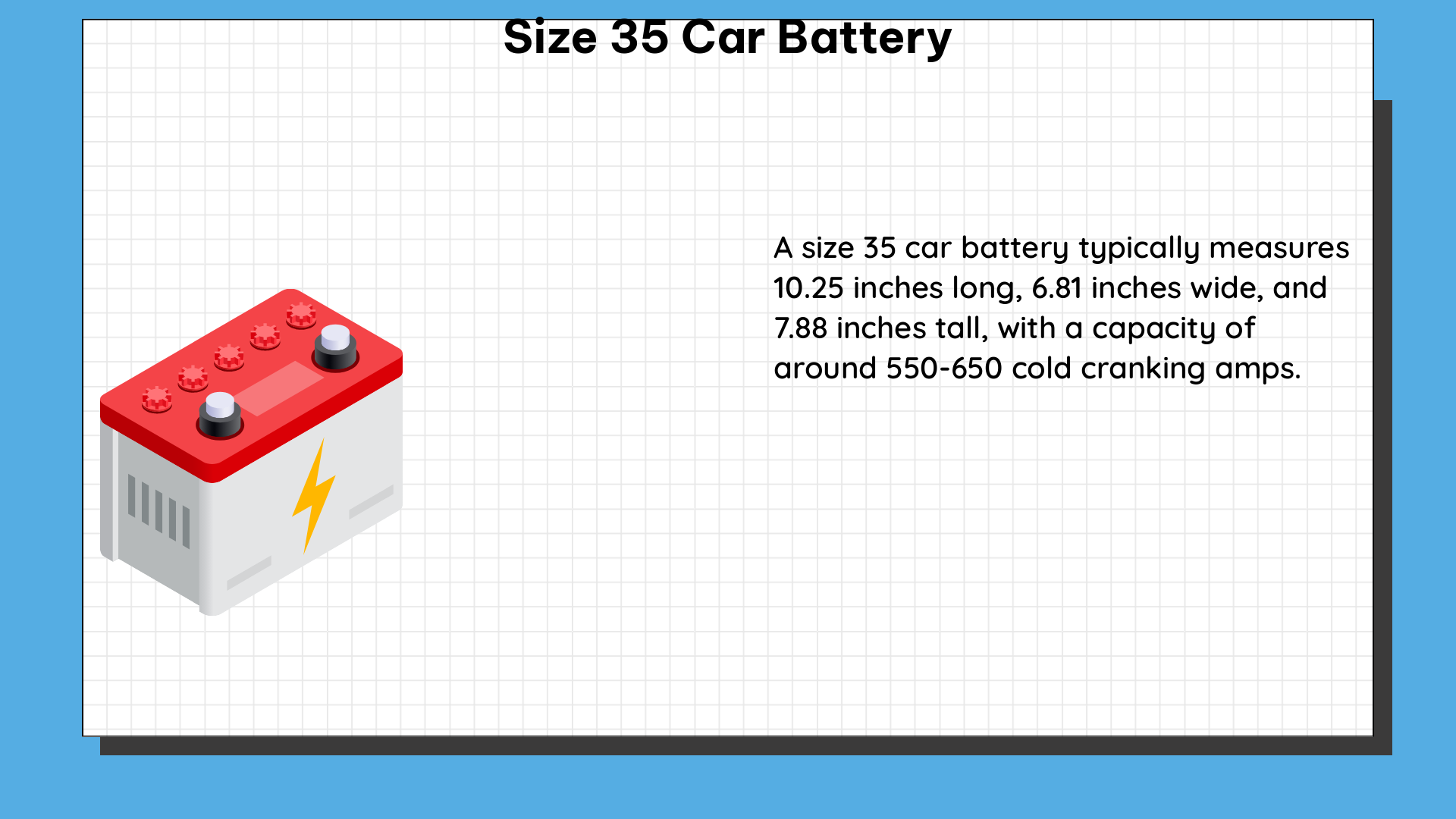The size 35 car battery, also known as Group 35, is a compact yet powerful battery designed to power a wide range of vehicles, from passenger cars to heavy-duty trucks. With its specific technical specifications and performance characteristics, the Group 35 battery plays a crucial role in ensuring the reliable operation of your vehicle’s electrical system.
Understanding the Dimensions of a Size 35 Car Battery
The size 35 car battery typically measures 9.1 inches in length, 6.9 inches in width, and 8.9 inches in height, making it a compact and space-saving option compared to larger battery groups. This compact size can be particularly advantageous in vehicles with limited battery tray space, such as the Toyota 4Runner, where users have debated the feasibility of fitting a larger Group 24F battery.
Comparing Size 35 to Other Battery Groups

While the size 35 battery is smaller than the Group 24F, it offers some distinct performance advantages. The Group 35 battery generally has a higher cold cranking amps (CCA) rating, which is a measure of the battery’s ability to start the engine in cold weather conditions. Typically, a size 35 battery can deliver between 500 to 800 CCA, depending on the specific model and manufacturer.
In addition to CCA, the Group 35 battery also boasts a higher reserve capacity, which is the amount of time the battery can power the vehicle’s electrical system without the engine running. This feature is particularly beneficial for drivers who frequently use accessories like lights, radio, or other electrical components while the engine is off.
| Battery Group | Dimensions (L x W x H, inches) | Cold Cranking Amps (CCA) | Reserve Capacity (minutes) |
|---|---|---|---|
| Group 35 | 9.1 x 6.9 x 8.9 | 500 – 800 | 90 – 120 |
| Group 24F | 10.3 x 6.8 x 8.9 | 450 – 750 | 80 – 100 |
Compatibility and Applications of Size 35 Batteries
The size 35 car battery is designed to be a direct replacement for a wide range of vehicles, including passenger cars, trucks, SUVs, and even some recreational vehicles like ATVs and snowmobiles. The Battery Council International (BCI) Group Sizes ensure that the replacement battery is compatible with the vehicle’s electrical system, providing a seamless fit and optimal performance.
When selecting a size 35 battery, it’s essential to consider the specific electrical requirements of your vehicle. Factors such as the engine size, accessory load, and driving conditions can all impact the battery’s performance and lifespan. It’s recommended to consult your vehicle’s owner’s manual or a qualified automotive technician to ensure you choose the right size 35 battery for your needs.
Maintenance and Care for Size 35 Batteries
Proper maintenance and care are crucial for ensuring the longevity and optimal performance of your size 35 car battery. Here are some key tips to keep in mind:
-
Regular Cleaning: Regularly clean the battery terminals and connections to prevent corrosion, which can impede the flow of electrical current and reduce the battery’s performance.
-
Voltage Monitoring: Regularly check the battery’s voltage to ensure it is within the recommended range, typically between 12.6 and 12.8 volts when the engine is off.
-
Charging and Recharging: If the battery is drained, recharge it using a suitable battery charger. Avoid overcharging, as this can damage the battery’s internal components.
-
Replacement Timing: Replace the size 35 battery when it reaches the end of its lifespan, typically every 3 to 5 years, or when it no longer holds a sufficient charge.
Conclusion
The size 35 car battery is a compact yet powerful option that offers a range of benefits, including higher CCA, greater reserve capacity, and compatibility with a wide variety of vehicles. By understanding the technical specifications and proper maintenance practices, you can ensure your size 35 battery provides reliable and long-lasting performance for your vehicle.
References:
- Comparison of Battery Group Sizes and Specifications
- Toyota 4Runner Forum Discussion on Group 24F vs. Group 35 Batteries
- Reddit Discussion on Group 25 and Group 35 Battery Interchangeability
- Battery Council International (BCI) Group Sizes
- Comparison of 24F, 27F, and 35 Group Batteries

The lambdageeks.com Core SME Team is a group of experienced subject matter experts from diverse scientific and technical fields including Physics, Chemistry, Technology,Electronics & Electrical Engineering, Automotive, Mechanical Engineering. Our team collaborates to create high-quality, well-researched articles on a wide range of science and technology topics for the lambdageeks.com website.
All Our Senior SME are having more than 7 Years of experience in the respective fields . They are either Working Industry Professionals or assocaited With different Universities. Refer Our Authors Page to get to know About our Core SMEs.